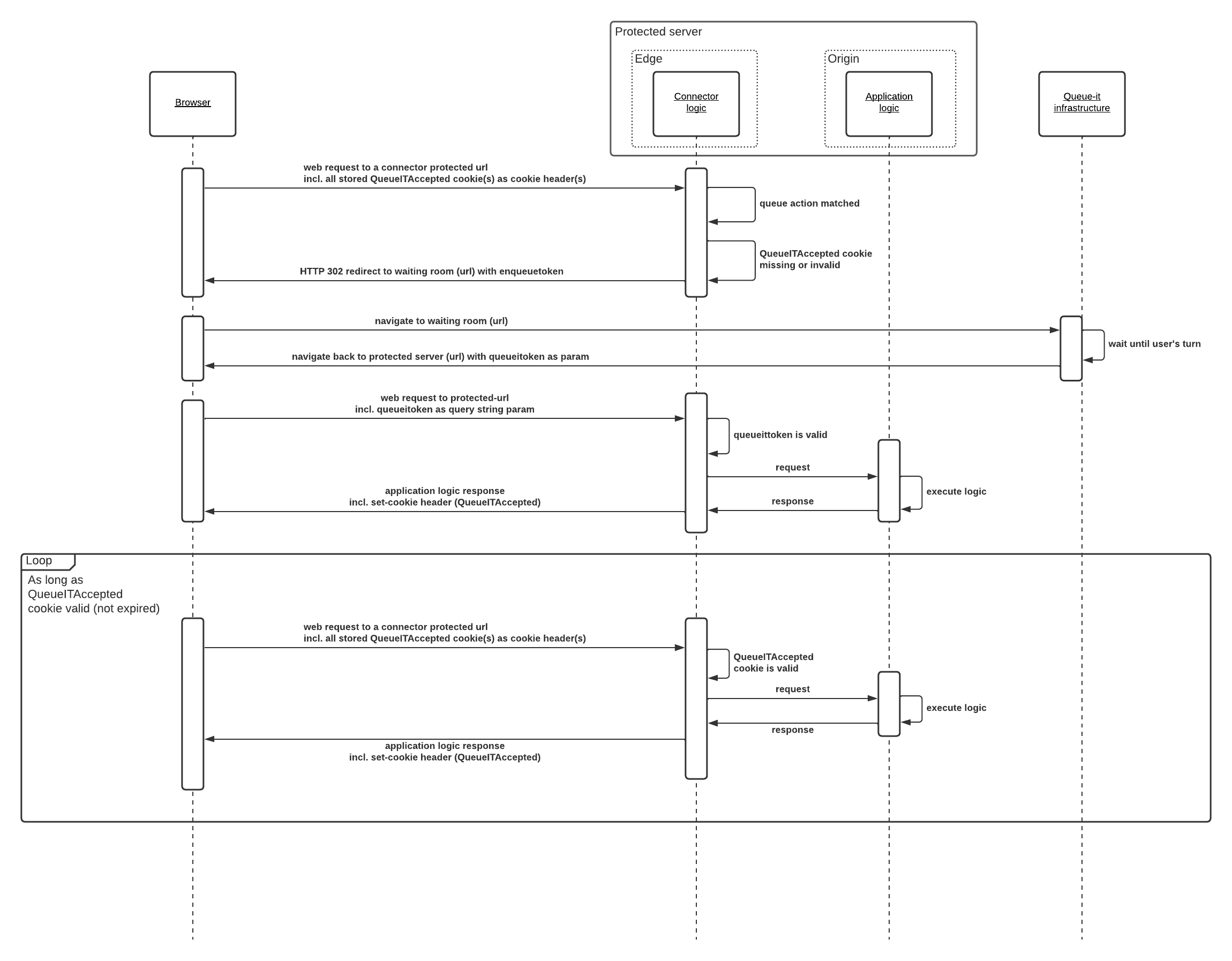Queue-it's Akamai Connector v4 uses Akamai EdgeWorkers to integrate an Akamai protected WebServer with Queue-it.
This page is intended to give a high-level technical overview of the Akamai Connector v4. To prevent malicious actors from compromising the security of our customer's high-profile sales and registrations, we host our in-depth Connector v4 documentation in private repositories.
If you need more detailed integration documentation than this page offers, connect with one of our technical experts who can understand your use case and determine the optimal setup for your tech stack.
The following diagram shows the Queue-it logic with an edge Connector.
- User requests a page.
- The validation method sees that user has no Queue-it session cookie and no Queue-it token and sends him to the correct waiting room with a valid token based on the configuration.
- User waits in the queue.
- User is navigated back to your website, now with a valid token.
- The validation method validates the token and creates a Queue-it session cookie.
- The user browses to a new page and the Queue-it session cookie will let him proceed without queuing again.
You can read more about Queue-it's edge compute integrations on our blog, and can find the full list of integrations on our Connectors page.

To integrate using the Queue-it Akamai Connector v4, you will need:
- An active Queue-it account
- An active Akamai account
- Queue-it admin available (Someone available with GO Queue-it Platform access and familiarity with GO account configuration settings.)
- Akamai admin available (Someone available with access to the customer Akamai account and familiarity with all existing Akamai environmental configurations like PM rules and variables and Edgeworkers)
- Akamai V4 Connector Download Access (Akamai admin must have been provisioned with access to secure Queue-it V4 Connector Github repository – not available for public access.)
- A non-production Akamai property that can be used for implementing and testing the new Queue-it connector.
The Akamai v4 Connector consists of the following components:
- EdgeWorker – code provided by Queue-it that enables the waiting room protection
- PM Variables – variables that hold key values used by the EdgeWorker.
- PM Rules – rules that provide coarse scope definition for the EdgeWorker protection and optionally also assist with integration configuration updates.
- Queue-it Integration Configuration - configuration information created in the GO Queue-it Platform and propagated to the Akamai environment to be leveraged by the Queue-it EdgeWorker. This configuration information provides finer definition of the protection scope.
Complete these steps in order for best results.
- Configure waiting rooms, actions, and triggers in Queue-it
- Create EdgeWorker
- Add PM variables
- Create PM rules
Waiting rooms and their protection scope are created and configured in the GO Queue-it Platform and any server-side (KnownUser) configuration information must be propagated to the Akamai environment for real-time access by the Queue-it EdgeWorker. When an integration configuration is saved (published) in the GO Queue-it Platform, the server-side configuration set-tings are packaged into a server-side JSON file and positioned on the Queue-it server, ready for secure downloading. Propagation of these settings (JSON) to the Akamai environment can be completed by one of three methods.
There are three options for configuration settings updating:
- Manual (inline) - Manually updating integration config within EdgeWorker code
- Auto-Pull (cache) - Dynamically download and cache integration config
- Push (edgekv) - Push integration config to Akamai EdgeKV
It's recommended to implement these configuration update methods in sequences for best results.
- Manual method - implement this method first and confirm new PM rules are activating Queue-it EdgeWorker
- Auto-Pull method – upgrade to this method to eliminate the need to update Akamai when Queue-it integration configuration changes
- Push method – this upgrade will propagate config updates to Akamai in near real-time
Queue-it's actions and triggers framework gives you a high degree of flexibility in determining what aspects of your site are covered by the virtual waiting room (see How Queue-it Works).
With the Connector v4, you can also create logic in your EdgeWorker. For instance, you can use PM rules to allow static assets like media files to bypass the Queue-it EdgeWorker for an otherwise-protected website.